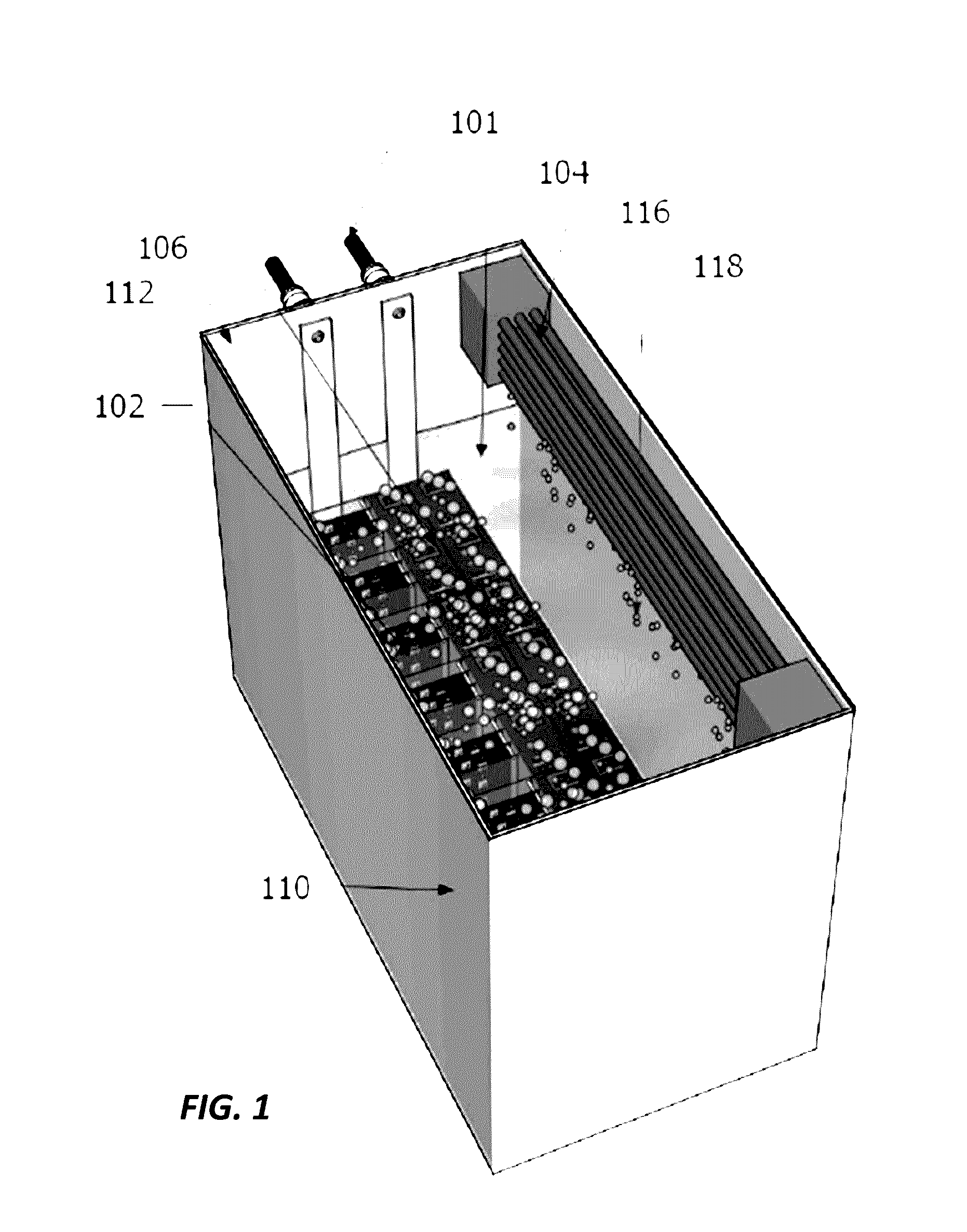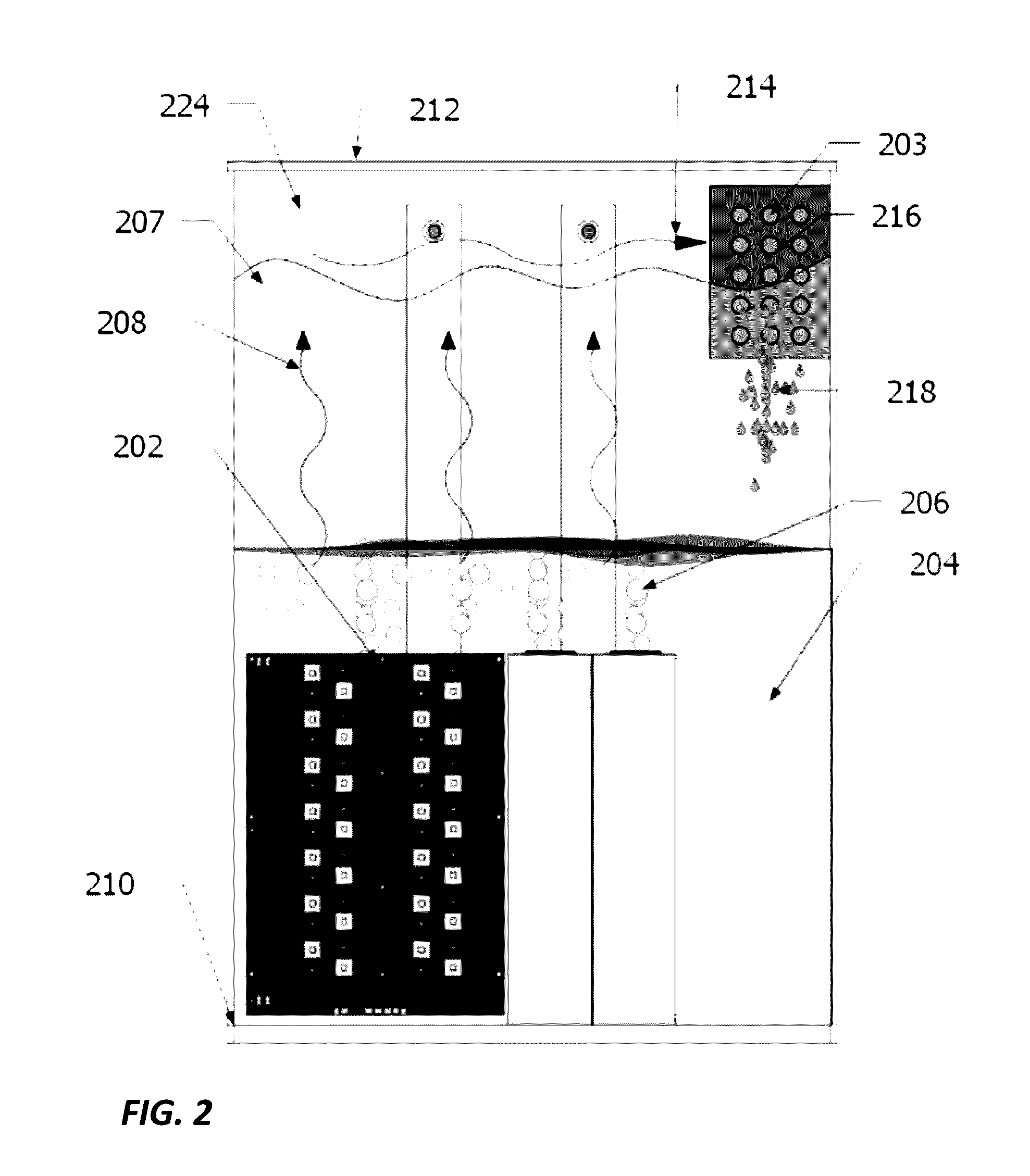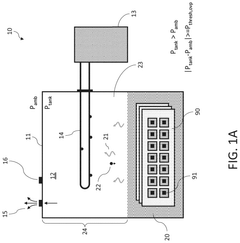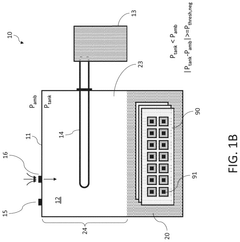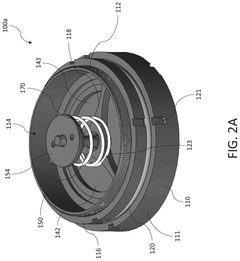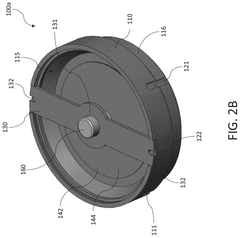Safety Cases And Fire Protection For Two-Phase Immersion Systems
AUG 22, 20259 MIN READ
Generate Your Research Report Instantly with AI Agent
Patsnap Eureka helps you evaluate technical feasibility & market potential.
Immersion Cooling Background and Safety Objectives
Immersion cooling technology has emerged as a revolutionary approach to thermal management in data centers and high-performance computing environments. This cooling method involves submerging electronic components directly in dielectric fluids that conduct heat but not electricity. The evolution of this technology can be traced back to the 1960s when it was first utilized in military and aerospace applications. However, it has gained significant traction in recent years due to increasing power densities in computing systems and the limitations of traditional air cooling methods.
Two-phase immersion cooling, specifically, leverages the phase change properties of dielectric fluids. When electronic components generate heat, the fluid absorbs this thermal energy, transitions from liquid to vapor state, rises to the top of the tank, condenses back to liquid form, and returns to the cycle. This process provides exceptional cooling efficiency, with the potential to handle heat loads exceeding 100 kW per rack, far surpassing the capabilities of conventional cooling systems.
The primary technical objectives for two-phase immersion systems center around maximizing cooling efficiency while ensuring operational safety. These systems aim to achieve uniform temperature distribution across all components, minimize thermal resistance, and provide reliable operation under varying load conditions. Additionally, they seek to reduce energy consumption compared to traditional cooling methods, with potential power usage effectiveness (PUE) values approaching 1.03, significantly lower than the industry average of 1.5-1.8 for air-cooled facilities.
Safety considerations represent a critical dimension of immersion cooling technology development. The presence of dielectric fluids in close proximity to high-voltage electronic components introduces unique safety challenges that must be addressed through comprehensive engineering controls and operational protocols. Fire protection becomes particularly important as these systems often operate in environments with significant electrical power, creating potential ignition sources.
The technical evolution trajectory points toward the development of more environmentally friendly dielectric fluids with improved thermal properties, enhanced system designs that facilitate maintenance while minimizing fluid exposure risks, and advanced monitoring systems capable of detecting potential safety issues before they escalate. Standardization efforts are also underway to establish industry-wide safety guidelines and best practices for immersion cooling implementations.
As data center power densities continue to increase and sustainability concerns drive efficiency improvements, immersion cooling technology is positioned to play an increasingly important role in next-generation computing infrastructure. The technical objectives therefore extend beyond performance metrics to include environmental sustainability, regulatory compliance, and integration with broader data center management systems.
Two-phase immersion cooling, specifically, leverages the phase change properties of dielectric fluids. When electronic components generate heat, the fluid absorbs this thermal energy, transitions from liquid to vapor state, rises to the top of the tank, condenses back to liquid form, and returns to the cycle. This process provides exceptional cooling efficiency, with the potential to handle heat loads exceeding 100 kW per rack, far surpassing the capabilities of conventional cooling systems.
The primary technical objectives for two-phase immersion systems center around maximizing cooling efficiency while ensuring operational safety. These systems aim to achieve uniform temperature distribution across all components, minimize thermal resistance, and provide reliable operation under varying load conditions. Additionally, they seek to reduce energy consumption compared to traditional cooling methods, with potential power usage effectiveness (PUE) values approaching 1.03, significantly lower than the industry average of 1.5-1.8 for air-cooled facilities.
Safety considerations represent a critical dimension of immersion cooling technology development. The presence of dielectric fluids in close proximity to high-voltage electronic components introduces unique safety challenges that must be addressed through comprehensive engineering controls and operational protocols. Fire protection becomes particularly important as these systems often operate in environments with significant electrical power, creating potential ignition sources.
The technical evolution trajectory points toward the development of more environmentally friendly dielectric fluids with improved thermal properties, enhanced system designs that facilitate maintenance while minimizing fluid exposure risks, and advanced monitoring systems capable of detecting potential safety issues before they escalate. Standardization efforts are also underway to establish industry-wide safety guidelines and best practices for immersion cooling implementations.
As data center power densities continue to increase and sustainability concerns drive efficiency improvements, immersion cooling technology is positioned to play an increasingly important role in next-generation computing infrastructure. The technical objectives therefore extend beyond performance metrics to include environmental sustainability, regulatory compliance, and integration with broader data center management systems.
Market Demand Analysis for Two-Phase Immersion Systems
The global market for two-phase immersion cooling systems is experiencing unprecedented growth, primarily driven by the escalating power demands of high-performance computing environments. Data centers worldwide are facing critical challenges in managing thermal loads efficiently, with traditional air cooling systems reaching their practical and economic limits. This technological shift has created a robust demand for immersion cooling solutions, with the market projected to grow at a CAGR of 24.8% through 2028.
The primary market segments demonstrating strong demand include hyperscale data centers, cryptocurrency mining operations, edge computing facilities, and high-performance computing (HPC) installations. Financial institutions and AI research centers are emerging as significant adopters, seeking solutions that can accommodate their increasingly dense computing infrastructures while maintaining operational reliability.
Energy efficiency represents a major demand driver, with organizations under mounting pressure to reduce their carbon footprint. Two-phase immersion cooling systems offer potential energy savings of 30-50% compared to traditional cooling methods, significantly reducing operational expenses and environmental impact. This efficiency advantage has become particularly compelling as electricity costs continue to rise globally and environmental regulations become more stringent.
Safety considerations are increasingly influencing purchasing decisions, with potential customers expressing concerns about fire risks, dielectric fluid handling, and regulatory compliance. Market research indicates that 78% of potential adopters cite safety as a "very important" or "critical" factor in their evaluation process. This heightened awareness has created a distinct market advantage for systems with comprehensive safety features and documented fire protection protocols.
Geographic demand patterns show notable regional variations. North America currently leads adoption rates, followed by Western Europe and parts of Asia-Pacific, particularly in countries with established data center hubs. Emerging markets in Southeast Asia, India, and the Middle East are showing accelerated interest, driven by rapid digital infrastructure development and challenging climate conditions that make traditional cooling methods less viable.
The market is also witnessing a shift in customer expectations regarding safety certification and compliance. Organizations are increasingly requiring vendors to provide detailed safety documentation, risk assessments, and compliance with standards such as NFPA 75, EN 13501, and ISO 20121. This trend is creating market differentiation opportunities for vendors who can demonstrate superior safety engineering and documentation.
Industry analysts predict that safety features will become a key competitive differentiator in the two-phase immersion cooling market, with customers willing to pay premium prices for systems with comprehensive fire protection measures and thorough safety documentation.
The primary market segments demonstrating strong demand include hyperscale data centers, cryptocurrency mining operations, edge computing facilities, and high-performance computing (HPC) installations. Financial institutions and AI research centers are emerging as significant adopters, seeking solutions that can accommodate their increasingly dense computing infrastructures while maintaining operational reliability.
Energy efficiency represents a major demand driver, with organizations under mounting pressure to reduce their carbon footprint. Two-phase immersion cooling systems offer potential energy savings of 30-50% compared to traditional cooling methods, significantly reducing operational expenses and environmental impact. This efficiency advantage has become particularly compelling as electricity costs continue to rise globally and environmental regulations become more stringent.
Safety considerations are increasingly influencing purchasing decisions, with potential customers expressing concerns about fire risks, dielectric fluid handling, and regulatory compliance. Market research indicates that 78% of potential adopters cite safety as a "very important" or "critical" factor in their evaluation process. This heightened awareness has created a distinct market advantage for systems with comprehensive safety features and documented fire protection protocols.
Geographic demand patterns show notable regional variations. North America currently leads adoption rates, followed by Western Europe and parts of Asia-Pacific, particularly in countries with established data center hubs. Emerging markets in Southeast Asia, India, and the Middle East are showing accelerated interest, driven by rapid digital infrastructure development and challenging climate conditions that make traditional cooling methods less viable.
The market is also witnessing a shift in customer expectations regarding safety certification and compliance. Organizations are increasingly requiring vendors to provide detailed safety documentation, risk assessments, and compliance with standards such as NFPA 75, EN 13501, and ISO 20121. This trend is creating market differentiation opportunities for vendors who can demonstrate superior safety engineering and documentation.
Industry analysts predict that safety features will become a key competitive differentiator in the two-phase immersion cooling market, with customers willing to pay premium prices for systems with comprehensive fire protection measures and thorough safety documentation.
Technical Challenges and Fire Risks Assessment
Two-phase immersion cooling systems present unique technical challenges and fire risks that require comprehensive assessment. The primary challenge stems from the combination of electrical components with dielectric fluids, creating potential ignition sources in proximity to flammable materials. Despite dielectric fluids being designed with high flash points, they remain combustible under certain conditions, particularly when heated beyond their thermal stability thresholds.
A significant technical hurdle involves the thermal management of high-density computing equipment. As power densities increase, particularly in AI and high-performance computing applications, the heat flux can exceed 100 kW/m², pushing cooling fluids to their operational limits. This creates localized hotspots that may degrade fluid properties over time, potentially reducing flash points and increasing fire risks.
The containment systems for these fluids present another challenge. Seals, gaskets, and other containment components must maintain integrity under thermal cycling conditions while preventing fluid leakage. Material compatibility issues between cooling fluids and system components can lead to degradation, increasing the risk of fluid escape and potential ignition.
Electrical safety considerations compound these challenges. Despite dielectric fluids being non-conductive by design, contamination from particulates, moisture, or fluid degradation products can alter electrical properties. This may create unforeseen conduction paths and potential arc flash hazards, particularly in high-voltage applications exceeding 400V.
Fire detection in immersion cooling environments presents unique difficulties. Traditional smoke detection systems may be ineffective as the fluid can suppress visible smoke during early fire stages. Heat detection systems must be calibrated to distinguish between normal operational temperatures and actual fire conditions, requiring sophisticated algorithms and sensor placements.
Suppression strategies face complications due to the enclosed nature of immersion systems. Conventional water-based suppression methods are contraindicated due to electrical hazards, while gas-based systems must account for the fluid's behavior during fire events. The potential for rapid thermal expansion of the cooling fluid during fire scenarios creates risks of pressure buildup and containment failure.
Regulatory compliance adds another layer of complexity, as standards specifically addressing two-phase immersion cooling remain limited. Current fire safety codes often lack specific provisions for these systems, creating uncertainty in compliance requirements and certification processes. This regulatory gap necessitates conservative engineering approaches and extensive testing to demonstrate safety equivalence.
A significant technical hurdle involves the thermal management of high-density computing equipment. As power densities increase, particularly in AI and high-performance computing applications, the heat flux can exceed 100 kW/m², pushing cooling fluids to their operational limits. This creates localized hotspots that may degrade fluid properties over time, potentially reducing flash points and increasing fire risks.
The containment systems for these fluids present another challenge. Seals, gaskets, and other containment components must maintain integrity under thermal cycling conditions while preventing fluid leakage. Material compatibility issues between cooling fluids and system components can lead to degradation, increasing the risk of fluid escape and potential ignition.
Electrical safety considerations compound these challenges. Despite dielectric fluids being non-conductive by design, contamination from particulates, moisture, or fluid degradation products can alter electrical properties. This may create unforeseen conduction paths and potential arc flash hazards, particularly in high-voltage applications exceeding 400V.
Fire detection in immersion cooling environments presents unique difficulties. Traditional smoke detection systems may be ineffective as the fluid can suppress visible smoke during early fire stages. Heat detection systems must be calibrated to distinguish between normal operational temperatures and actual fire conditions, requiring sophisticated algorithms and sensor placements.
Suppression strategies face complications due to the enclosed nature of immersion systems. Conventional water-based suppression methods are contraindicated due to electrical hazards, while gas-based systems must account for the fluid's behavior during fire events. The potential for rapid thermal expansion of the cooling fluid during fire scenarios creates risks of pressure buildup and containment failure.
Regulatory compliance adds another layer of complexity, as standards specifically addressing two-phase immersion cooling remain limited. Current fire safety codes often lack specific provisions for these systems, creating uncertainty in compliance requirements and certification processes. This regulatory gap necessitates conservative engineering approaches and extensive testing to demonstrate safety equivalence.
Current Fire Protection Solutions for Immersion Systems
01 Fire suppression systems for immersion cooling
Two-phase immersion cooling systems require specialized fire protection due to the flammable nature of some dielectric fluids. These systems incorporate fire detection sensors, automatic suppression mechanisms, and containment strategies to prevent fire spread. Advanced designs include integrated fire suppression that can detect temperature anomalies and activate extinguishing agents specifically formulated for electrical fires in liquid environments.- Fire suppression systems for immersion cooling: Two-phase immersion cooling systems require specialized fire protection mechanisms due to the flammable nature of some dielectric fluids. These systems often incorporate automatic fire detection and suppression technologies specifically designed for electrical equipment environments. The fire suppression systems may use inert gases, specialized chemical agents, or other methods that can extinguish fires without damaging the sensitive electronic components submerged in the cooling fluid.
- Safety monitoring and detection systems: Advanced monitoring systems are essential for two-phase immersion cooling safety. These systems continuously track critical parameters such as fluid levels, temperature, pressure, and the presence of contaminants or vapors. Early detection mechanisms can identify potential hazards before they escalate into dangerous situations. Integrated alarm systems alert operators to abnormal conditions, while automated shutdown procedures can be triggered when safety thresholds are exceeded.
- Containment and leak prevention technologies: Preventing leaks and containing the dielectric fluid are critical aspects of two-phase immersion system safety. These systems employ specialized seals, gaskets, and structural designs to ensure fluid containment. Secondary containment systems can capture any leaks that might occur from the primary vessel. Advanced designs incorporate leak detection sensors that can identify even minor fluid escapes, allowing for immediate response before significant hazards develop.
- Material compatibility and fluid safety standards: The selection of appropriate materials and fluids is crucial for safe operation of two-phase immersion systems. Dielectric fluids must meet specific safety standards regarding flammability, toxicity, and environmental impact. Components used in these systems must be compatible with the chosen cooling fluid to prevent degradation or chemical reactions. Industry standards and regulations govern the testing, certification, and handling of these specialized materials to ensure consistent safety across different implementations.
- Emergency response and risk management protocols: Comprehensive emergency response protocols are essential for managing incidents in two-phase immersion cooling environments. These include detailed procedures for power isolation, fluid containment, personnel evacuation, and fire response. Risk assessment methodologies help identify potential hazards specific to immersion cooling installations. Training programs ensure that operators and emergency responders understand the unique challenges of these systems and can take appropriate action during incidents.
02 Safety monitoring and control systems
Comprehensive monitoring systems are essential for two-phase immersion cooling safety. These include real-time sensors for temperature, pressure, fluid level, and leak detection with automated shutdown protocols. Advanced systems incorporate predictive analytics to identify potential failure points before they become critical. Redundant control mechanisms ensure system integrity even during partial failures, with remote monitoring capabilities allowing for immediate response to safety concerns.Expand Specific Solutions03 Leak detection and containment solutions
Specialized leak detection systems for two-phase immersion cooling environments utilize multiple sensing technologies to identify fluid escapes at early stages. These systems incorporate secondary containment structures, automated isolation valves, and drainage systems to prevent dielectric fluid spread. Advanced solutions include self-sealing components and specialized materials that resist degradation from cooling fluids while maintaining structural integrity during thermal cycling.Expand Specific Solutions04 Electrical isolation and grounding techniques
Proper electrical isolation is critical in two-phase immersion systems to prevent electrical hazards. These techniques include specialized insulation materials compatible with dielectric fluids, dedicated grounding systems for immersed components, and isolation barriers between high-voltage elements. Advanced designs incorporate fault detection circuits that can immediately de-energize systems upon detecting electrical anomalies, with redundant safety mechanisms to prevent accidental energization during maintenance.Expand Specific Solutions05 Emergency response and maintenance safety protocols
Comprehensive emergency protocols for two-phase immersion cooling systems include specialized training for personnel, clearly defined evacuation procedures, and equipment for safe handling of dielectric fluids. Maintenance safety features incorporate lockout/tagout systems, specialized tools for working with immersed components, and personal protective equipment designed for the unique hazards of these environments. Documentation systems ensure proper recording of all safety incidents and maintenance activities for continuous improvement.Expand Specific Solutions
Key Industry Players in Immersion Cooling Technology
Two-phase immersion cooling technology for data centers is in a growth phase, with the market expanding rapidly due to increasing demand for efficient thermal management solutions. The global market size is projected to reach significant scale as data centers seek sustainable cooling alternatives. Technologically, the field shows varying maturity levels across companies. Industry leaders like Intel and 3M Innovative Properties have established advanced safety protocols and fire protection systems for immersion cooling, while specialized players such as Aspen Aerogels and Chemours are developing innovative dielectric fluids and thermal materials. Companies including Delta Electronics and Carrier are integrating comprehensive safety cases into their immersion cooling solutions, addressing fire risks through advanced detection and suppression technologies. Emerging players like Wiwynn and AEWIN Technologies are rapidly advancing their capabilities to meet growing market demands.
3M Innovative Properties Co.
Technical Solution: 3M has developed advanced Novec engineered fluids specifically designed for two-phase immersion cooling systems with integrated fire protection capabilities. Their dielectric fluids feature high heat transfer efficiency while maintaining non-flammability characteristics (flash point >200°C), making them inherently safer than traditional cooling methods. 3M's safety case approach incorporates comprehensive risk assessment methodologies that address thermal runaway scenarios, electrical safety concerns, and material compatibility issues. Their system design includes specialized containment vessels with pressure relief mechanisms, fluid level monitoring sensors, and automated shutdown protocols that activate when abnormal conditions are detected. Additionally, 3M has implemented redundant safety systems including vapor detection sensors that can identify potential leaks before they become hazardous and integrated fire suppression systems that can operate even in the event of primary system failure.
Strengths: Non-flammable dielectric fluids provide inherent fire protection; comprehensive safety integration from fluid to system design; extensive testing and certification documentation. Weaknesses: Higher initial implementation costs compared to traditional cooling; requires specialized training for maintenance personnel; system modifications needed when adapting to different hardware configurations.
Intel Corp.
Technical Solution: Intel has pioneered safety protocols for two-phase immersion cooling systems in data centers, focusing on both prevention and containment strategies. Their approach integrates hardware-level thermal monitoring with specialized immersion-compatible server designs that feature sealed connectors and corrosion-resistant components. Intel's safety case framework addresses multiple risk vectors including electrical isolation, fluid degradation monitoring, and emergency response procedures. Their systems incorporate continuous dielectric strength testing of the cooling fluid to detect contamination that could compromise safety. For fire protection, Intel employs a multi-layered approach with primary prevention through non-conductive fluid selection, secondary containment systems with automated fluid drainage capabilities, and tertiary fire suppression systems using inert gas deployment that won't damage electronic components. Intel has also developed specialized training programs and maintenance protocols that address the unique safety requirements of immersion cooling environments, including proper handling of dielectric fluids and emergency response procedures specific to two-phase systems.
Strengths: Comprehensive integration with server hardware design; extensive testing data from large-scale deployments; sophisticated monitoring systems that can predict potential failures before they occur. Weaknesses: Solutions primarily optimized for data center environments rather than broader applications; proprietary nature of some safety systems limits interoperability with third-party components.
Critical Safety Patents and Technical Documentation
Immersion cooling system with low fluid loss
PatentActiveUS20170064862A1
Innovation
- A two-phase immersion cooling system design incorporating a cooling basin, condensing chamber, primary and secondary condensers, vapor redirection structures, and volume compensation devices to minimize fluid loss by redirecting vaporized fluid into the condensing chamber and preventing its flow into a secondary chamber, along with a secondary condenser and fluid paths with one-way valves to manage fluid flow.
Pressure relief valve and adsorbent chamber for two-phase immersion cooling systems and methods for using same
PatentPendingUS20240404916A1
Innovation
- A pressure relief valve with a poppet assembly and adsorbent chamber is introduced, capable of supporting high flow rates and operating at a low cracking pressure, integrated into outlet and inlet valve assemblies to manage pressure fluctuations by releasing or absorbing air and coolant vapor, thereby maintaining stable tank pressure.
Regulatory Compliance Framework for Cooling Technologies
The regulatory landscape for two-phase immersion cooling technologies spans multiple jurisdictions and standards bodies, creating a complex compliance framework that data center operators and technology providers must navigate. At the international level, organizations such as the International Electrotechnical Commission (IEC) and the International Organization for Standardization (ISO) have established baseline safety standards that influence regional and national regulations. These standards address electrical safety, fire protection, and environmental considerations relevant to immersion cooling systems.
In the United States, the National Fire Protection Association (NFPA) codes, particularly NFPA 75 (Standard for the Fire Protection of Information Technology Equipment) and NFPA 70 (National Electrical Code), provide critical guidelines for fire safety in data centers implementing immersion cooling. The Occupational Safety and Health Administration (OSHA) regulations further govern workplace safety aspects related to handling dielectric fluids and maintaining immersion cooling infrastructure.
European regulatory frameworks, including the European Union's ATEX Directive for explosive atmospheres and the EN 60079 series of standards, establish requirements for equipment used in potentially hazardous environments. These are particularly relevant for two-phase immersion systems where vapor phases may create specific safety considerations. The EU's REACH and RoHS directives also impact the selection and management of cooling fluids based on their chemical composition and environmental impact.
Asian markets, particularly Japan and China, have developed their own regulatory approaches. Japan's High Pressure Gas Safety Act applies to certain two-phase cooling systems, while China's GB standards address both electrical safety and environmental aspects of cooling technologies. These regional variations necessitate customized compliance strategies for global technology deployment.
Industry-specific standards from organizations like ASHRAE (American Society of Heating, Refrigerating and Air-Conditioning Engineers) provide technical guidelines that, while not always legally binding, often become de facto requirements through industry adoption and insurance prerequisites. ASHRAE Technical Committee 9.9 has developed thermal guidelines specifically addressing liquid cooling technologies that influence design and operational practices.
Certification programs such as UL (Underwriters Laboratories) listings for components and systems provide standardized verification of safety compliance. The UL 60950-1 standard for information technology equipment safety has particular relevance for immersion cooling implementations, addressing hazards related to electrical shock, energy, fire, mechanical issues, and thermal concerns.
In the United States, the National Fire Protection Association (NFPA) codes, particularly NFPA 75 (Standard for the Fire Protection of Information Technology Equipment) and NFPA 70 (National Electrical Code), provide critical guidelines for fire safety in data centers implementing immersion cooling. The Occupational Safety and Health Administration (OSHA) regulations further govern workplace safety aspects related to handling dielectric fluids and maintaining immersion cooling infrastructure.
European regulatory frameworks, including the European Union's ATEX Directive for explosive atmospheres and the EN 60079 series of standards, establish requirements for equipment used in potentially hazardous environments. These are particularly relevant for two-phase immersion systems where vapor phases may create specific safety considerations. The EU's REACH and RoHS directives also impact the selection and management of cooling fluids based on their chemical composition and environmental impact.
Asian markets, particularly Japan and China, have developed their own regulatory approaches. Japan's High Pressure Gas Safety Act applies to certain two-phase cooling systems, while China's GB standards address both electrical safety and environmental aspects of cooling technologies. These regional variations necessitate customized compliance strategies for global technology deployment.
Industry-specific standards from organizations like ASHRAE (American Society of Heating, Refrigerating and Air-Conditioning Engineers) provide technical guidelines that, while not always legally binding, often become de facto requirements through industry adoption and insurance prerequisites. ASHRAE Technical Committee 9.9 has developed thermal guidelines specifically addressing liquid cooling technologies that influence design and operational practices.
Certification programs such as UL (Underwriters Laboratories) listings for components and systems provide standardized verification of safety compliance. The UL 60950-1 standard for information technology equipment safety has particular relevance for immersion cooling implementations, addressing hazards related to electrical shock, energy, fire, mechanical issues, and thermal concerns.
Environmental Impact and Sustainability Considerations
Two-phase immersion cooling systems present significant environmental advantages over traditional air cooling methods, primarily through their substantial reduction in energy consumption. These systems typically achieve 30-50% lower Power Usage Effectiveness (PUE) compared to conventional data center cooling technologies, directly translating to reduced carbon emissions. The dielectric fluids used in immersion cooling have varying environmental profiles that must be carefully evaluated. While some fluids have high Global Warming Potential (GWP), newer engineered fluids are being developed with significantly lower environmental impact metrics, including reduced GWP values below 2,000 and improved biodegradability characteristics.
The lifecycle assessment of immersion cooling systems reveals additional sustainability benefits. These systems generally require less raw material for construction compared to traditional cooling infrastructure, eliminating the need for raised floors, computer room air handlers, and extensive ductwork. The extended equipment lifespan resulting from more stable operating temperatures further enhances sustainability by reducing electronic waste generation. Studies indicate that hardware in immersion environments can experience up to 30% longer operational lifespans, significantly decreasing the environmental burden of manufacturing replacement components.
Waste heat recovery represents another critical environmental advantage of two-phase immersion systems. The higher-grade heat captured from these systems (typically 50-60°C) can be effectively repurposed for district heating, greenhouse operations, or other industrial processes. This heat recovery potential creates opportunities for circular economy applications that are difficult to achieve with traditional air cooling methods, where waste heat is typically too diffuse to capture efficiently.
Water conservation benefits also distinguish immersion cooling systems in regions facing water scarcity. Unlike many traditional cooling towers that consume substantial quantities of water through evaporation, two-phase immersion systems operate in closed loops with minimal water requirements. This characteristic becomes increasingly valuable as water stress intensifies in many regions globally, offering data center operators a path to dramatically reduce their water footprint while maintaining cooling efficiency.
The end-of-life considerations for immersion cooling fluids require careful management protocols. Most manufacturers have established recycling programs for dielectric fluids, ensuring proper reclamation and reprocessing. The development of biodegradable alternatives continues to advance, though challenges remain in balancing environmental performance with the thermal and electrical properties required for effective cooling applications.
The lifecycle assessment of immersion cooling systems reveals additional sustainability benefits. These systems generally require less raw material for construction compared to traditional cooling infrastructure, eliminating the need for raised floors, computer room air handlers, and extensive ductwork. The extended equipment lifespan resulting from more stable operating temperatures further enhances sustainability by reducing electronic waste generation. Studies indicate that hardware in immersion environments can experience up to 30% longer operational lifespans, significantly decreasing the environmental burden of manufacturing replacement components.
Waste heat recovery represents another critical environmental advantage of two-phase immersion systems. The higher-grade heat captured from these systems (typically 50-60°C) can be effectively repurposed for district heating, greenhouse operations, or other industrial processes. This heat recovery potential creates opportunities for circular economy applications that are difficult to achieve with traditional air cooling methods, where waste heat is typically too diffuse to capture efficiently.
Water conservation benefits also distinguish immersion cooling systems in regions facing water scarcity. Unlike many traditional cooling towers that consume substantial quantities of water through evaporation, two-phase immersion systems operate in closed loops with minimal water requirements. This characteristic becomes increasingly valuable as water stress intensifies in many regions globally, offering data center operators a path to dramatically reduce their water footprint while maintaining cooling efficiency.
The end-of-life considerations for immersion cooling fluids require careful management protocols. Most manufacturers have established recycling programs for dielectric fluids, ensuring proper reclamation and reprocessing. The development of biodegradable alternatives continues to advance, though challenges remain in balancing environmental performance with the thermal and electrical properties required for effective cooling applications.
Unlock deeper insights with Patsnap Eureka Quick Research — get a full tech report to explore trends and direct your research. Try now!
Generate Your Research Report Instantly with AI Agent
Supercharge your innovation with Patsnap Eureka AI Agent Platform!

